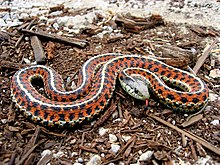Garter Snake
| Garter snake | |
|---|---|
 |
|
| Coast garter snake Thamnophis elegans terrestris |
|
| Scientific classification | |
| Kingdom: | Animalia |
| Phylum: | Chordata |
| Class: | Reptilia |
| Order: | Squamata |
| Suborder: | Serpentes |
| Family: | Colubridae |
| Tribe: | Thamnophiini |
| Genus: |
Thamnophis Fitzinger, 1843 |
| Species | |
|
See text |
|
 |
|
| Thamnophis distribution | |
| Synonyms | |
|
Atomarchus, Chilopoma, Eutaenia, Eutainia, Phamnovis, Prymnomiodon, Stypocemus, Tropidonote, Tropidonotus |
|
See text
Atomarchus, Chilopoma, Eutaenia, Eutainia, Phamnovis, Prymnomiodon, Stypocemus, Tropidonote, Tropidonotus
Garter snake, sometimes incorrectly called garden snake or gardener snake, is the common name given to the nearly harmless, small to medium-sized snakes belonging to the genus Thamnophis. Endemic to North America, they can be found from the Subarctic plains of Canada to Central America. The garter snake is the state reptile of Massachusetts.
With no real consensus on the classification of species of Thamnophis, disagreement between taxonomists and sources, such as field guides, over whether two types of snakes are separate species or subspecies of the same species is common. Garter snakes are closely related to the genus Nerodia (water snakes), with some species having been moved back and forth between genera.
Garter snakes are present throughout most of North America. They have a wide distribution due to their varied diets and adaptability to different habitats, with varying proximity to water; however, in the western part of North America, these snakes are more aquatic than in the eastern portion. Garter snakes populate a variety of habitats, including forests, woodlands, fields, grasslands, and lawns. They almost exclusively inhabit areas with some form of water, often an adjacent wetland, stream, or pond. This reflects the fact that amphibians are a large part of their diet.
Garter snakes have complex systems of pheromonal communication. They can find other snakes by following their pheromone-scented trails. Male and female skin pheromones are so different as to be immediately distinguishable. However, male garter snakes sometimes produce both male and female pheromones. During the mating season, this ability fools other males into attempting to mate with them. This causes the transfer of heat to them in kleptothermy, which is an advantage immediately after hibernation, allowing them to become more active. Male snakes giving off both male and female pheromones have been shown to garner more copulations than normal males in the mating balls that form at the den when females enter the mating melee.
...
Wikipedia

